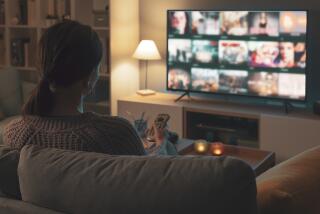PERSONAL HEALTH : Junk Food Is Prime Fare for Prime Time
- Share via
The weather’s too hot for exercise, or you’re too tired, and you settle in for an evening of television-watching.
Don’t be surprised if you’re ravenous by the news at 11. It’s not your fault. According to two University of Minnesota nutrition experts, you can blame those hunger pangs on “the Prime-Time Diet.”
During a single half-hour of programs and commercials, today’s viewer is exposed to an average of 4.8 food references, according to Mary Story, assistant professor of public health, and Patricia Faulkner, a university nutritionist.
The two analyzed 11 prime-time shows, including commercials, and reported the results recently in the American Journal of Public Health. “The vast majority of eating on prime-time television involves junk food,” said Story.
More than half of the food references in TV programs, the researchers found, were to low-nutrient beverages and sweets. In the 22 separate episodes analyzed, there were 86 occasions of eating or drinking.
Nearly three-quarters of all food eaten on prime-time shows is eaten between meals, said the researchers. Less than 10% of foods consumed were fruits or vegetables. “If people ate (in real life) the way they eat on television, they would not only be obese,” Story said, “they would have one foot in the grave. You never see the consequences of TV eating. With the exception of Roseanne (on the show of the same name), there are very few overweight characters.”
While all shows analyzed by the two researchers fell short of promoting healthy nutrition, NBC’s “Golden Girls” is cited by Story as a particularly bad example. On the show, which depicts the lives of four women in their “golden years,” the actresses often sit around the kitchen table.
“Using food to fulfill emotional needs and to deal with stress seems to be a recurrent theme,” Story said. “As soon as they have their cheesecake, they’re fine. What they could do instead is go for a walk. It’s more constructive and less fattening.”
“Probably,” agreed Marc Sotkin, “Golden Girls” executive producer. “But it’s just not as funny to go out and take a walk. We’re reflecting how people really act, maybe with some exaggeration.”
The show’s nutritional messages have improved, he said, noting the lack of ice cream binges in recent shows. “They used to go into sugar coma when talking about their problems.” And those cheesecake scenes? They’re part of the show’s format, said Sotkin. “ ‘Rose, let’s get out the tofu’ really doesn’t work as well,” added Sotkin, who says he eats a bit of tofu himself.
The Minnesota research results came as no surprise to Jody Lander Spector, a dietitian who directs the weight control program at St. Vincent Medical Center, Los Angeles. Her overweight clients are keenly aware of the omnipresent food references on television, she said. “One woman, after her first week of dieting, told me she counted 57 food commercials from 8 p.m. until bedtime,” Spector said.
Story suggests consumers write letters of protest to television stations, asking for more healthful portrayals of eating. She said she hopes that her research will persuade television writers and producers to incorporate more healthful dietary messages into shows. Until then, she tells consumers: “Be aware that television does not always portray good messages about nutrition.”
Spector’s advice? Stock the refrigerator with healthy foods so you won’t be tempted to eat the junk food you just saw advertised on a commercial. “Walk to the video store or the frozen yogurt store,” said Spector. “And use the remote control to turn down the volume on junk food commercials.”





